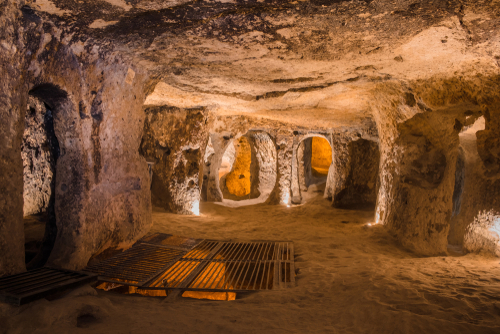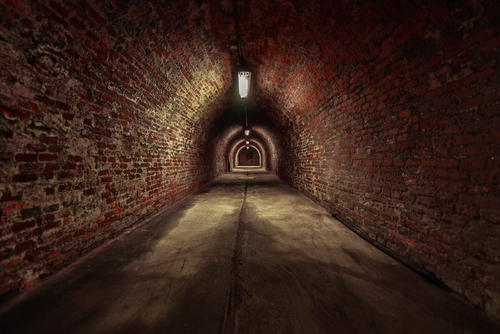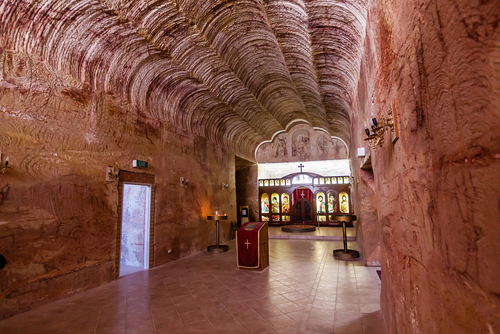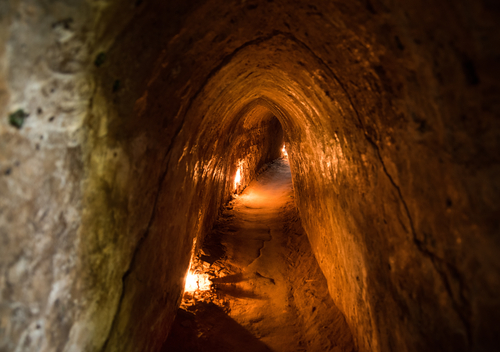Beneath the world we know lie mysterious underground cities and hidden tunnels—real places with fascinating histories and remarkable stories to tell. These subterranean worlds don’t just reveal how humans survived threats, but also showcase remarkable engineering feats and resourcefulness.
From ancient cities carved deep into the earth to Cold War-era shelters and modern towns that still thrive underground today, we’re exploring some of the most incredible underground worlds in this Remitly guide.
What are underground cities?
When we talk about underground cities, we aren’t just referring to basements or metro systems. These are deliberate, often extensive networks of hidden tunnels, rooms, and chambers built beneath the earth’s surface and designed to support human life below ground.Some are small, with only a few passageways. But others stretch for miles, including living quarters, gathering spaces, and even areas for work or worship.
Why were underground cities built?
Throughout history, people built subterranean spaces for practical and often life-saving reasons:
- Protection from extreme climates: Underground living provided natural insulation against searing heat or harsh winters.
- Defense against threats: Hidden tunnels kept families safe during invasions and wars.
- Religious persecution: Secret rooms allowed people to worship when practicing openly was unsafe.
- Work and resources: Mining communities often lived near or inside the tunnels where they worked, like in the Wieliczka Salt Mine, which housed Polish miners for centuries.
These unique spaces reflect the ingenuity of civilizations adapting to extreme conditions and threats, demonstrating human resilience across centuries.
Different types of subterranean structures
Underground settlements range from simple cave-like dwellings to elaborate cities with multiple levels, wells, kitchens, chapels, and even places for commerce.
Some are ancient wonders that still baffle historians, while others are modern relics of political anxiety. And a few, remarkably, are still bustling with life today.
But whether carved out of rock or constructed beneath the soil, these underground settlements all have one thing in common—they provided shelter, protection, and refuge in times of need.
Ancient marvels: Derinkuyu, Turkey

Derinkuyu is one of the most remarkable underground cities in the world. Located in Turkey’s Cappadocia region, it stretches more than 250 feet below the surface. Once, it could shelter up to 20,000 people, along with their livestock, food stores, and supplies.
The city spans 18 levels. Stables were located near the surface and family dwellings deeper inside, coupled with storage rooms, chapels, and communal halls. Altogether, Derinkuyu offers a glimpse into how entire communities once lived underground.
Providing safety in uncertain times
Cappadocia has long been a crossroads of empires, with communities often facing raids and shifting rulers. Derinkuyu was likely built as a protective measure against these threats.
Over the centuries, different groups relied on Derinkuyu for safety. The Persians, Seljuks, and later, Byzantine Christian communities all expanded or occupied the city. It became especially important during the 7th-century Islamic raids, giving Christian families a place to hide safely underground.
Defensive features such as circular stone doors—each weighing close to half a ton—could be rolled shut from the inside to seal off passageways. Meanwhile, small openings in the centers allowed defenders to fight off attackers safely. Narrow tunnels forced attackers to stoop or pass single-file, further enhancing security.
An engineering showcase
Derinkuyu’s engineering is extraordinary. The city’s design illustrates its builders’ remarkable foresight and adaptability.
- Ventilation: How do you get fresh air deep underground? Derinkuyu solved the challenge by incorporating more than 50 shafts into its design. Thousands of smaller ducts then distributed clean air across the settlement, ensuring continuous airflow. Some shafts were booby-trapped to prevent intruders from using them, while others let in shafts of natural light.
- Water supply: Wells and cisterns tapped into groundwater and stored rainwater to provide fresh water throughout the settlement. Ingeniously, these wells were engineered so they could be sealed from the inside, preventing contamination from the surface and protecting residents during sieges.
- Strategic layout: Animals were kept near the surface for warmth, while food was stored deeper in cellars to preserve it. Carved presses for wine and olive oil—along with tall amphoras for storage—show how families sustained themselves for long periods.
- Community spaces: Chapels, vaulted halls, and even a Byzantine-era missionary school are proof that life underground wasn’t just about survival, but also about maintaining social and religious practices.
Walking through history today
Today, Derinkuyu is a popular tourist destination, inviting visitors to wander through its carved corridors and hidden chambers. It’s now part of the UNESCO World Heritage Site of Göreme National Park and the Rock Sites of Cappadocia.
The city offers not only a peek at ancient engineering, but also a connection to a globally treasured cultural landscape. Walking through the tunnels provides a powerful sense of the skill and inventiveness of the people who created and lived in this subterranean world.
Cold War relics: the tunnels of Beijing, China

Beneath Beijing, China, lies Dixia Cheng, a vast underground network built in the 1970s at the height of Cold War tensions.
Commissioned by the Chinese government, the “Underground City” was designed to protect citizens in case of disaster. Its tunnels stretch approximately 18 miles in length and are situated 26 to 60 feet below ground. They cover more than 52 square miles.
Prepared for the worst
Dixia Cheng was created as a massive bomb shelter to protect against potential nuclear attacks and air raids during a period of global uncertainty. Unlike traditional underground settlements used for daily living or safety during wartime, Dixia Cheng was a precautionary measure. It was ready to house Beijing’s population in an emergency, providing defense from both man-made and natural disasters.
In fact, when completed, Dixia Cheng could accommodate up to 300,000 people for about four months. The tunnels once had around 90 hidden entrances, cleverly concealed in shops, homes, and parks across Beijing. A map drawn in fluorescent ink—invisible to the naked eye—was discovered on the wall of one shop, showing how only the right people could find the settlement.
A city beneath the city
The Underground City was outfitted to function as a self-sufficient shelter, including:
- Living and public spaces: Restaurants, clinics, schools, and even a roller skating rink created a parallel city underground
- Industrial and utility areas: Factories and supply storage supported long-term habitation if needed.
- Protective infrastructure: Thick concrete gates, gas- and water-proof hatches, and sealable ventilation systems ensured safety from chemical or nuclear hazards.
- Water supply: Wells could be dug to provide fresh water in emergencies.
Although much of Dixia Cheng is now closed to the public, parts of the tunnel network remain accessible, offering a haunting reminder of Cold War fears. The surviving passages and exhibits reveal how seriously Beijing once prepared for global conflict.
A subterranean town: Coober Pedy, Australia

Coober Pedy, located in South Australia, is often called the “opal capital of the world.” This unique town was established in 1916, when the first opal was discovered in the area. It has since become famous not only for its gemstones but also for its unique underground settlement. Today, an estimated 1,500 residents live beneath the surface in dugouts—homes carved into the hillsides that provide relief from the desert extremes.
Escaping the relentless sun
The desert heat in southern Australia can be unforgiving, with summer temperatures frequently climbing above 104°F. It’s believed that soldiers returning from the trenches of France during World War I introduced the idea of underground living to the area, adapting “dugouts” into permanent homes.
The miners who settled here quickly discovered the advantages: underground rooms stay naturally insulated, maintaining a steady 66–77°F year-round, regardless of how harsh the climate is outside.
Thriving beneath the desert
Coober Pedy’s underground settlement is surprisingly modern and functional. It features:
- Homes: Many dugouts include bedrooms, a kitchen, living areas, and bathrooms, offering all the comforts of an above-ground house while staying cool year-round.
- Community spaces: The town also has underground churches, shops, and hotels, integrating daily life and commerce below ground.
- Notable sites: The Serbian Orthodox Church of Saint Elijah is a beautiful underground place of worship that blends spiritual significance with practical design.
- Mining integration: Many homes were expanded from old opal mines, so they combine living quarters with workspaces, reflecting the town’s dual focus on mining and habitation.
- Scale and expansion: Stable sandstone soil allows for massive underground rooms, with some dugouts spreading across 4,840 square feet. Families sometimes buy adjoining properties and tunnel between them, creating interconnected underground mansions.
- Airflow and insulation: Ventilation shafts keep air circulating, while the natural rock provides consistent temperature regulation.
About half of Coober Pedy’s population still lives underground, enjoying the benefits of naturally regulated temperatures and protection from desert winds and dust storms. Visitors can explore homes, churches, and hotels carved into the rock, and guided tours explain how locals transformed mining tunnels into living spaces. Staying overnight in an underground hotel offers a rare chance to experience firsthand how this community thrives beneath the desert surface.
Secret passageways: Cu Chi Tunnels, Vietnam

Less than 45 miles from Ho Chi Minh City, Vietnam, lie the Cu Chi Tunnels, a vast underground network of hidden tunnels originally constructed beneath the jungle terrain.
Built during the late 1940s by Viet Minh guerrillas during the First Indochina War, the hidden tunnels were later expanded and extensively used by the Viet Cong throughout the Vietnam War. The network stretched over 155 miles at its peak, forming a complex subterranean ecosystem.
A strategy of survival
The tunnels were built as a strategic survival tool. They allowed Viet Cong fighters to move undetected, store supplies, communicate between areas, and survive heavy bombardments.
Concealed entrances and carefully placed booby traps made the tunnels extremely difficult for enemy forces to navigate. Trapdoors were disguised under foliage or even shaped like termite mounds, while smoke from cooking fires was cleverly dispersed through hidden chimneys. For US soldiers, the tunnels were a constant source of frustration, while for the Vietnamese fighters, they were lifelines that supported prolonged resistance.
Ingenious design in the dark
The Cu Chi Tunnels were remarkably compact—around 28 inches in height and 16 inches in width. They were built to suit the smaller stature of Vietnamese fighters while preventing larger Western soldiers from maneuvering easily. Inside, conditions were harsh: cramped, humid, and poorly stocked, constantly under threat from disease, insects, and poisonous animals. Despite these challenges, soldiers lived, worked, and fought underground for extended periods.
These hidden tunnels were ingeniously designed to support daily and military life:
- Living quarters where soldiers could rest, cook, and eat meals.
- Supply routes that allowed the movement of weapons, food, and information.
- Hospitals and command centers hidden safely underground for medical treatment and mission planning.
- Booby traps and concealed entrances that made it nearly impossible for enemy forces to find and navigate.
- Air vents and wells that provided fresh air and water even in the deepest sections.
Crawling through history
Today, parts of the Cu Chi Tunnels are preserved as historic sites. The Ben Dinh Tunnels section, often visited by tourists, has been widened for easier access: passages are now about four feet high and 2.6 feet wide. The Ben Duoc Tunnels section retains much of its original size and conditions, offering a more authentic experience.
Guided tours allow visitors to crawl through narrow corridors, explore command centers, and see the conditions that soldiers once endured. It’s a sobering yet fascinating journey, offering a glimpse into the sacrifice of those who fought and lived below ground
Looking back, beneath our feet
From the ancient depths of Derinkuyu to the Cold War-inspired passages of Dixia Cheng, from a desert town in Australia to wartime tunnels in Vietnam, underground cities show how humans have always adapted to challenges—with creativity and resilience.
These hidden tunnels remind us that much of history lies just beneath our feet in a vast subterranean world, whether born of necessity, fear, or ingenuity. Some were never used, others became thriving communities, and a few still shape daily life today.
Is There Any Connection Between Steep Staircases and the Design of Underground Cities?
Exploring the architectural marvels of underground cities, one intriguing aspect is understanding the steepness of dutch staircases. These steep designs often maximize space in constrained environments, allowing for efficient navigation. This connection reveals how historical necessity shaped urban planning, enhancing the functional elegance of subterranean living.
FAQs
What is the largest underground city in the world?
The largest known underground city in the world is Derinkuyu, Turkey, which could shelter up to 20,000 people across multiple levels.
Are any underground cities still inhabited today?
Yes. Coober Pedy in Australia is still a thriving underground town where residents live, shop, and worship below the surface.
Can you visit these underground cities and tunnels?
Yes, you can visit many underground cities and tunnels. Derinkuyu is open to tourists, parts of the Cu Chi Tunnels in Vietnam are preserved for visitors, and Coober Pedy welcomes travelers to go on tours and stay in underground hotels. Some areas of Dixia Cheng in Beijing are also occasionally open to the public.